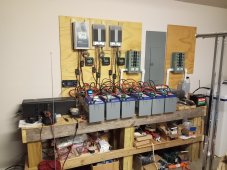My house has 320a service coming into a meter base with two disconnects feeding two panels inside the garage with all of the house circuits. It is overkill but when I built the house a few years ago, I wanted plenty of expansion room. Right now I have one panel that has all of the important backup circuits (refrigerator, freezer, well pump, some lights, etc.) and it has a generator inlet for when the power goes out. I'm in the country so when it goes out, we are usually the last to come back on.
Eventually I would to take the whole house off grid but it is just not in the budget right now. So my idea was to disconnect one of the inside panels from the grid and powering those circuits via solar and battery backup. Effectively having the important circuits on the solar/battery system and the other less important and load-heavy circuits like the HVAC, oven, dryer, etc. still stay on the grid for now until I can expand the solar and battery backup system.
My biggest concern is grounding. Right now the inside panels are "subpanels" because the outside meter base is the first means of disconnect. So that is where the neutral and ground is bonded. If I split the house into two systems, am I creating a big grounding no-no situation?
Eventually I would to take the whole house off grid but it is just not in the budget right now. So my idea was to disconnect one of the inside panels from the grid and powering those circuits via solar and battery backup. Effectively having the important circuits on the solar/battery system and the other less important and load-heavy circuits like the HVAC, oven, dryer, etc. still stay on the grid for now until I can expand the solar and battery backup system.
My biggest concern is grounding. Right now the inside panels are "subpanels" because the outside meter base is the first means of disconnect. So that is where the neutral and ground is bonded. If I split the house into two systems, am I creating a big grounding no-no situation?



